PALACES, PEACOCKS AND PRANA – India Travelogue
by Lisa Spiller


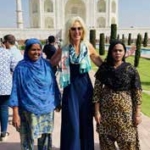
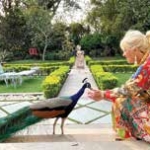
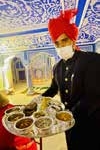 On my custom guided Micato Safaris journey to India this spring, the magic began when our plane touched down in Delhi after a 15-hour flight. We were whisked off to the Taj Palace Hotel, where one easily finds an exotic mix of guests dressed in saris and turbans, business suits, and sparkling cocktail dresses.
On my custom guided Micato Safaris journey to India this spring, the magic began when our plane touched down in Delhi after a 15-hour flight. We were whisked off to the Taj Palace Hotel, where one easily finds an exotic mix of guests dressed in saris and turbans, business suits, and sparkling cocktail dresses.
After a sound sleep in plush surroundings, we travelled to Jaipur where we checked into the iconic Taj Rambagh Palace, the former royal residence of the most beloved Maharaja of Jaipur, Sawai Man Singh II.
We were greeted by ecstatic horns, ceremonial drums, and brightly dressed belly dancers swirling in circles around a handlebar mustachiode whirling dervish. Stately uniformed doormen in ruby turbans and cross-body sashes greeted us “Namaste.” A dozen concierges in pink embroidered saris welcomed us with fragrant flower leis and pink hibiscus champagne.
They escorted us up a Grand staircase, past marble inlaid fountains, through sandstone arches and down gilded breezeways into opulent royal suites. My suite featured a four-poster bed, plump pink velvet pillows in a sunny window box and French doors opening to a sprawling marble terrace overlooking manicured gardens where dozens of wild peacocks and monkeys darted between roses and bougainvillea.
The royal executive chef prepared an Indian-Asian feast in the Gold Room, where otherwise important dignitaries have been entertained for decades. We were butler-served on 24K gold-plated custom Versace China, drank wine out of 24K gold goblets, and with each 24K gold forkful, we ogled the three 150-year-old Murano glass chandeliers overhead.
I visited the spa in the afternoon where I swam in the same pool as the honorable Maharani Gayatri Devi did during her residency as the third wife of the beloved Maharaja. As I stepped from spa into lush rose gardens, exotic birds called from the flowering trees, the arid breeze rustled palm leaves, and gentle, inquisitive resident peacocks curiously approached and allowed me to feed them right from the palm of my hand.
A horse-drawn carriage rolled up alongside me and a dark bearded footman in a jeweled turban hopped off, pulled out a stepping stool, presented his white gloved hand and asked me if I wanted a ride. With the clap of hooves and peacock calls, I was driven through the sun-dappled grounds until the clock on the palace tower struck 5 pm, at which time I ran inside like Cinderella to freshen up for our evening adventure.
As dusk fell, we traveled to a private farm where one can go “glamping with the elephants.” Free-roaming elephants greeted us and eagerly devoured alfalfa, molasses, and bananas which we fed them with our bare hands. We trekked elephants through the bush until the exotic music of a snake charmer and snake dancers lured us into a forest glen. Mesmerized by the exotic ritual, we let the elephants wander off and immersed ourselves in the magic of the moment. While the performed, henna artists tattooed our hands with intricate artwork, and we drank wine with our free hand.
Here in the bush, under the glow of fire torches, we were served a traditional Indian dinner of barbecue chicken with masala sauce, spaghetti with lamb, steamed vegetables, naan, and rice. Our dinner conversation with our Indian guide Hemendre Singh, turned to holy cows, yoga, karma, reincarnation, and the caste system. The Hindu believe that they have three mothers, Mother Earth, their birth mother, and the cow. All three give life and are considered sacred.
While India is home to many exotic animals including tigers, elephants, camels, peacock, antelope, and wild boar, cows wander freely everywhere. You will find them gathered in the middle of busy four- lane highways, in doorways and on sidewalks. The cow has the right of way while humanity toils around them.
Yoga is a way of life for the Hindu culture.“Yoga helps your flame burn slow.” Namaste, “I bow to you” is used as hello, goodbye, and thank you.
Karma serves as the compass from which all kindness flows, “whatsoever you sow, so you shall reap” and “there is a consequence foreverything.”
Reincarnation is their belief that every living creature goes through life cycles. The monkey, the ant, the peacock could all be beloved ancestors in another life cycle. The cow is the last lifecycle before humanity.
In the Hindu culture, one is born into acaste and dies in the same caste. The castesystem consists of warriors, brahmins, workers,and traders. Our guide was of the warriorcaste and was a step farmer. We suspected hehad royal ties because he was invited by theMaharaja to the royal box at the polo groundsthe following week.
Splice together the movies Octopussy, Aladdin, Crazy Rich Asians, Monsoon Wedding and Slumdog Millionaire and insert yourself into the picture; this is what a blockbuster luxury vacation to India looks like.
Lisa is a Luxury Travel Advisor with Preferred Travel of Naples.
To contact Lisa: Lisa@PreferredNaples.com I 239-450-1746 I www.PreferredNaples.com

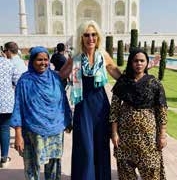
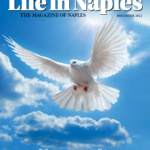

Leave a Reply
Want to join the discussion?Feel free to contribute!